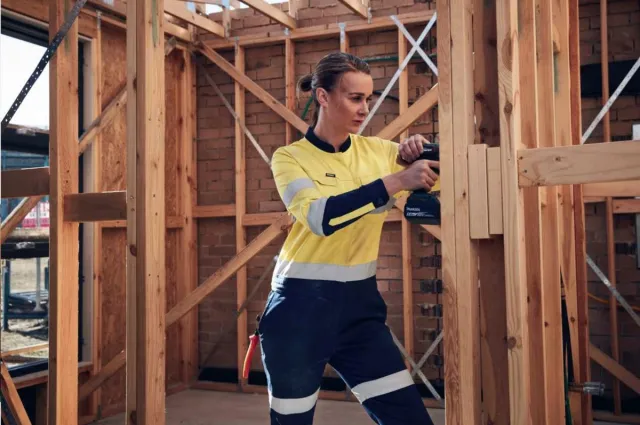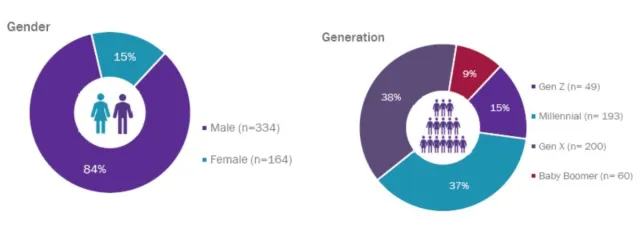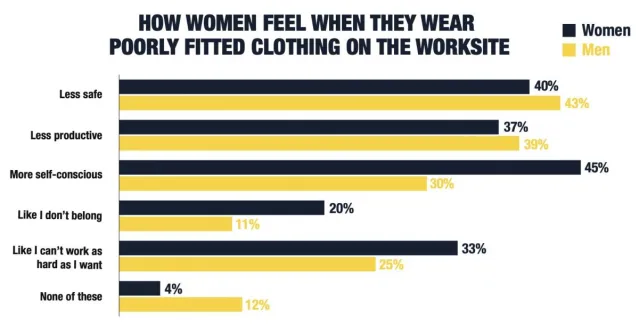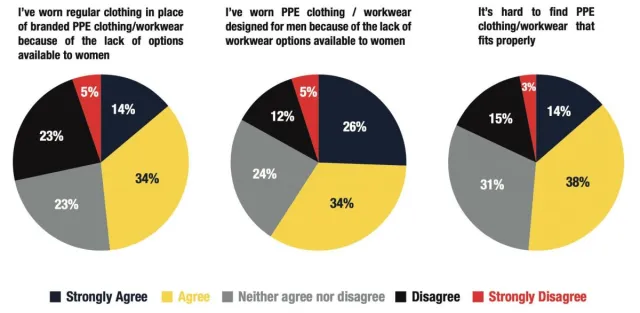Want to read in Dutch? Click here
The importance of proper workwear for women, especially in the industrial sector, is something I’ve emphasized in my articles before. Just like the fact that this clothing has only been made for a few years and many women still wear men’s workwear on a daily basis.
How difficult is it actually for women to find good workwear and what does it do to you when you wear men’s workwear? Australian company Bisley Workwear has conducted research on this. Time for some hard numbers!

Research
During the research, various Australian individuals working in the industrial sector were interviewed. The group consisted of 334 men and 164 women. I think it’s very good that both men and women were surveyed. This allows for a good comparison of how the different genders experience workwear.
The largest group was between 39 and 64 years old (38%), followed by the category of 65 years and older (37%). The latter category included Generation Z and millennials (24%), aged 18 to 39.
When scrutinizing the numbers, one will notice that the total adds up to 99%, so one percent is missing. I have seen this in the research before. Sometimes the total was 99% and sometimes 101%. I have tried to contact Bisley Workwear several times, but unfortunately, I have not received a response to my question about the percentages. However, my other questions about this research were answered. I assume it’s a small mistake where one percentage was forgotten to be calculated.

Research shows the consequences of poorly fitting women’s workwear
Both men and women were surveyed about how it feels to wear workwear that doesn’t fit well.
Firstly, it appears that fewer women feel unsafe (40%) than men (43%) when wearing ill-fitting clothing. On the other hand, women (33%) wearing this clothing feel quicker that they can’t work as hard as men (25%). Also, 20% of women feel like they don’t belong when wearing it. While only 11% of men have this feeling when wearing poorly fitting workwear.

Research shows the consequences of poorly fitting women’s workwear In addition to the feelings caused by the clothing, it has also been examined how women deal with it when they can’t find good workwear.
The figures show that 57% wore regular clothing because there was no good women’s workwear available. Of the surveyed women, 46% have worn men’s workwear for this reason. And in total, 53% indicate having trouble finding good workwear.

Consequences of poorly fitting women’s workwear
When I look at the figures, a few things stand out.
Firstly, I feel that women underestimate the impact of ill-fitting clothing. The figures show that of the women wearing this clothing, 40% feel less safe and 37% are less productive. Additionally, 33% feel that they can’t work as hard as they would like. I don’t quite understand the difference between being less productive and not being able to work as hard, but in both cases, I find the percentage very low. I expected that wearing improper workwear would have more influence.
In practice
I discussed the figures with Femke Hendriks. As a defense employee (and former saleswoman of workwear), she knows what it’s like to have to work in men’s clothing. And through her experience, she now knows that this is a persistent problem.
“Many women don’t even know that women’s workwear exists. And if you don’t know that there’s an alternative, you can’t compare, of course. That’s why I think women are generally quite mild in their judgment.
While ill-fitting workwear can indeed be obstructive during your work. I know what it’s like to wear men’s clothing and have to pull up your pants regularly. Because it’s too big in certain places, you can also get caught on things more easily. Or it fits too tightly somewhere, causing it to pinch or chafe. Often, the knee pads on your pants, for example, are also not positioned correctly, so you are less well protected.
It was so bad that during my pregnancy, I could even continue wearing my workwear until 32 weeks. All I did was make a small insert in the pants for my belly. When I finally went on maternity leave, many didn’t even know I was pregnant. That’s how oversized the clothing I had to wear was.”
One of the guys
Hendriks believes it’s mainly the employer’s responsibility to handle this better.
“Many employers find it too much trouble to purchase separate clothing for a few women. It takes more time and energy. So, the women are offered men’s workwear. While this clothing actually makes it harder to work well. And because women often want to be ‘one of the guys,’ you’re less likely to hear them complain. I see this reflected in these figures too.
But with unisex clothing, you don’t take into account the female body. That’s why I always advise employers to let women wear actual women’s workwear. There are more and more clothing brands where there’s no difference in appearance between men and women. They look the same, only the women’s clothing is actually made for their body.”
Time for change
It’s clear: workwear for women is not a luxury. It provides a better feeling, a safer environment, and it’s a good way to show your appreciation towards female employees.
Greetings,
Aileen
